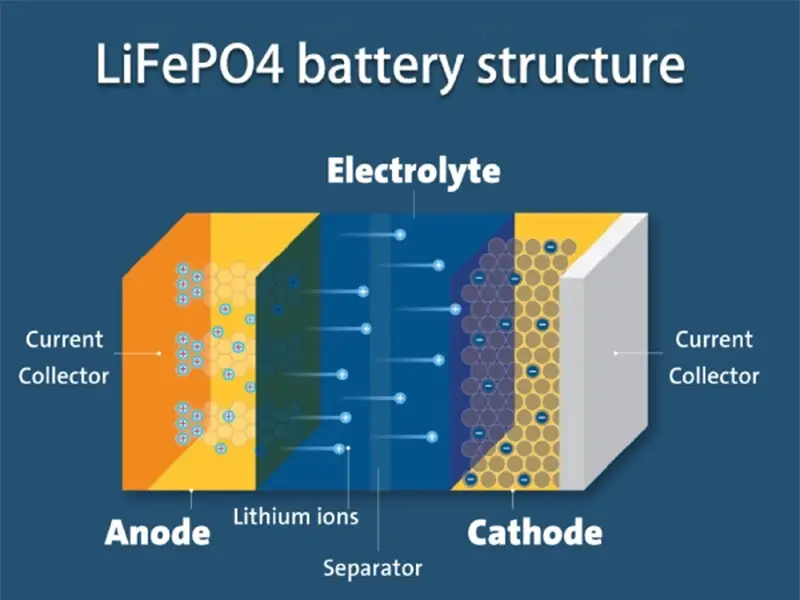Introduction to LiFePO4 Batteries: What Makes Them Different
Understanding LiFePO4 Chemistry
LiFePO4 batteries have a unique chemical composition of lithium (Li), iron (Fe), and phosphate (PO4). Understanding this arrangement is key to grasping how it influences their performance, stability, and safety. Lithium ions serve as the primary charge carriers, moving between the anode and cathode during the charging and discharging processes. Iron as the cathode enhances stability, reducing the risk of overheating and thermal runaway.
The phosphate component is particularly significant in the battery’s design. It forms a stable crystal structure that binds strongly with lithium ions, contributing to the battery’s superior cycle life. This robust structure enables LiFePO4 batteries to withstand thousands of charge cycles without significant degradation in capacity. LiFePO4 batteries have lower energy density but offer better safety, ideal for those prioritizing safety and longevity.
Additionally, LiFePO4’s electrochemical properties provide reliable performance under extreme conditions, such as high temperatures or heavy load demands. This makes them particularly well-suited for applications in renewable energy storage, electric vehicles (EVs), and stationary storage solutions. Understanding the chemistry of LiFePO4 helps explain why it continues to gain preference in the competitive battery technology landscape.
Key Advantages of LiFePO4 Batteries
LiFePO4 batteries stand out for several distinct advantages, which make them increasingly popular across various industries.
- Superior Safety: One of the most significant benefits of LiFePO4 batteries is their safety. LiFePO4’s stability reduces risks like overheating and fire. This makes it ideal for safety-critical applications, such as electric vehicles and renewable energy.
- Exceptional Thermal Stability: LiFePO4 batteries can operate across a broad range of temperatures without compromising performance. Unlike other lithium-ion batteries, LiFePO4 performs well in extreme heat. This increases its reliability and longevity. This feature is especially advantageous in applications like outdoor energy systems and electric transportation, where temperature fluctuations are common.
- Extended Lifespan: LiFePO4 batteries boast a remarkable cycle life. They endure over 2,000 charge-discharge cycles with minimal capacity loss. This makes them ideal for long-term applications like solar energy storage and electric vehicles. Their long lifespan also reduces replacement costs, making them a more cost-effective choice in the long run.
- High Discharge Efficiency: LiFePO4 batteries deliver high current efficiently. This makes them ideal for high-drain applications like power tools, electric vehicles, and consumer electronics.
Electric vehicle manufacturers are increasingly choosing LiFePO4. Its balance of safety, longevity, and performance makes it the preferred option. Similarly, solar energy storage systems benefit from LiFePO4’s reliability, ensuring energy storage solutions function smoothly over extended periods.
Limitations and Challenges of LiFePO4 Technology
Despite the numerous advantages, LiFePO4 batteries do have some limitations.
1,Lower Energy Density:
“LiFePO4 batteries have lower energy density than chemistries like NMC or LCO. This results in more space and weight for the same energy. It makes them less ideal for space- and weight-sensitive applications like electric vehicles and portable devices.”
2,Cycling Efficiency:
“While LiFePO4 batteries offer long cycle life, their charge-discharge efficiency can be affected by factors like temperature, design, and BMS quality. These can impact performance, especially in high-demand applications.”
3,Initial Production Cost:
“LiFePO4’s raw materials are cheaper, but manufacturing is complex, making initial production costs higher. As production scales, costs should decrease, improving competitiveness in price-sensitive markets.”
Future Trends and Innovations in LiFePO4 Battery Technology
The future of LiFePO4 technology is promising. Trends and innovations will improve its performance and applications.
- LiFePO4 batteries are gaining popularity in electric vehicles, renewable energy, and consumer electronics. Their safety, lifespan, and stability drive rapid market growth.
- Innovations in manufacturing, like automation and advanced materials, will reduce costs and enhance battery performance. These developments will play a critical role in making LiFePO4 batteries more affordable and widely adopted.
- Smarter Battery Management Systems (BMS): The evolution of battery management systems will further optimize LiFePO4 performance. Smart BMS solutions will incorporate advanced algorithms and real-time monitoring to enhance thermal management, prolong battery life, and prevent failures. Predictive maintenance capabilities will also ensure that LiFePO4 batteries operate at peak efficiency for longer periods.
- Sustainability and Eco-Friendliness: LiFePO4 batteries are more eco-friendly than other lithium-ion chemistries. They align with the growing focus on sustainability.Their non-toxic composition and recyclability contribute to a greener energy future. Research will improve energy density and reduce environmental impact. This will strengthen LiFePO4’s role in clean energy.
As innovations unfold, LiFePO4 batteries will become more integral to renewable energy. They will play a key role in sustainable technologies.


